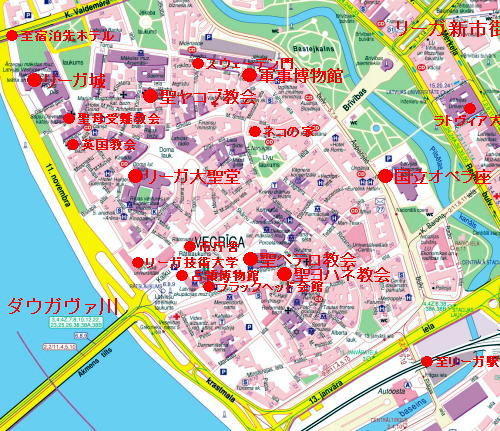ƒfƒ“ƒ}پ[ƒNپ@پ@ƒٹƒgƒAƒjƒAپ@پ@ƒ‰ƒgƒ”ƒBƒAپ@پ@ƒGƒXƒgƒjƒAپ@پ@ƒtƒBƒ“ƒ‰ƒ“ƒhپ@ “ءڈW‘S‘ج
| پyƒ‰ƒgƒ”ƒBƒAپEƒٹپ[ƒKپz | پyƒٹپ[ƒKژO‘ه”ژ•¨ٹظپz |
| ƒVƒƒƒEƒŒƒC‚©‚çƒٹپ[ƒK‚ض | ƒ‰ƒgƒ”ƒBƒAŒRژ–”ژ•¨ٹظ‡@ |
| پyƒٹپ[ƒK‹ŒژsٹXپE—ًژj’n‹وپz | ƒ‰ƒgƒ”ƒBƒAŒRژ–”ژ•¨ٹظ‡A |
| ƒnƒ“ƒU“¯–؟‚ئ‚ح | ƒ‰ƒgƒ”ƒBƒAگè‹’ق”ژ•¨ٹظ‡@ |
| ‹ŒژsٹX–k•”پEƒٹپ[ƒK‘هگ¹“° | ƒ‰ƒgƒ”ƒBƒAگè‹’ق”ژ•¨ٹظ‡A |
| ژs’،ژةپEگ¹ƒyƒeƒچ‹³‰ï | ƒ‰ƒgƒ”ƒBƒAگè‹’ق”ژ•¨ٹظ‡B |
| ƒMƒƒƒ‰ƒٹپ[‚إŒ©‚½ڈGˆيƒpƒbƒ`ƒڈپ[ƒN | ƒ‰ƒgƒ”ƒBƒAگè‹’ق”ژ•¨ٹظ‡C |
| ژ©—R‹L”O”èپA‰بٹwƒAƒJƒfƒ~پ[ | ‚P‚X‚X‚P”NƒoƒٹƒPپ[ƒh‹L”Oٹظ |
پœ‚Q‚O‚P‚O”N‚QŒژ‚P‚X“ْپi‹àپjپ@ƒ‰ƒgƒ”ƒBƒAŒRژ–”ژ•¨ٹظ‡@


ƒٹپ[ƒK‹ŒژsٹXگ}
چىگ¬پFگآژR’هˆê
پ@‚QŒژ‚P‚X“ْ‚ح’‹‰ك‚¬‚ـ‚إ”ژ•¨ٹظژ‹ژ@‚¾پBƒRƒCƒ“‚ھ‚ ‚é‚ج‚إژش‚ًƒoƒ‹ƒ@ƒi’ت‚è‚ئƒrƒ‹ƒZپ[ƒ^ƒXگى‚ھŒً‚ي‚铹کH‚ج’“ژشƒXƒyپ[ƒX‚ة’“ژش‚³‚¹“k•à‚إ”ژ•¨ٹظ‚ك‚®‚è‚ًچs‚¤پB
پ@چإڈ‰‚ة–K–â‚·‚é”ژ•¨ٹظ‚حپAƒ‰ƒgƒ”ƒBƒAŒRژ–”ژ•¨ٹظ‚¾پB
پ@“r’†پAƒٹپ[ƒK‹ŒژsٹX‚إ—L–¼‚بپuƒlƒR‚ج‰ئپv(Kaku Maja)‚ج‘O‚ً’ت‚éپB

ƒlƒR‚ج‰ئ
پ@ژB‰eپFگآژR’هˆê Nikon CoolPix S8پ@19 Feb. 2010

ƒlƒR‚ج‰ئ
پ@ژB‰eپFگآژR’هˆê Nikon CoolPix S8پ@19 Feb. 2010
پ@پ¦ƒlƒR‚ج‰ئ‚ج‚¢‚ي‚ê
پ@‚»‚جگجپA‚±‚ج‰ئ‚ة‚ح—T•ں‚بƒ‰ƒgƒ”ƒBƒAڈ¤گl‚ھڈZ‚ٌ‚إ‚¢‚½پBڈ¤گl‚ح‘هƒMƒ‹ƒh‚ة‰ء‚ي‚肽‚©‚ء‚½‚ھپAژ‘ٹi‚ھ‚ ‚ء‚½‚ة‚à‚©‚©‚ي‚炸پAƒ‰ƒgƒ”ƒBƒAگl‚إ‚ ‚é‚ئ‚¢‚¤‚±‚ئ‚إپAƒhƒCƒcگl‚ھژx”z“I‚بƒMƒ‹ƒh‚ض‚جژQ‰ء‚ً‹‘”غ‚³‚ꂽپB“{‚ء‚½ڈ¤گl‚ح‘هƒMƒ‹ƒg‚ج‰ïٹظپiƒuƒ‰ƒbƒNƒwƒbƒh‰ïٹظپj‚ة‚¨گK‚ًŒü‚¯‚½ƒlƒR‚ً‰®چھ‚جڈم‚ةژو‚è•t‚¯‚½پB‚±‚ê‚ةƒMƒ‹ƒh‚حŒƒ“{‚µ‚½‚ھڈ¤گl‚حپu‚ ‚ب‚½•û‚ح‹K‘¥‚ًژ‚ء‚ؤ‚¢‚é‚ج‚ةپA‚»‚ê‚ًژç‚ç‚ب‚¢پBژ„‚جƒlƒR‚ح‹K‘¥‚ب‚ا‚à‚ء‚ؤ‚¢‚ب‚¢‚ج‚¾‚©‚çپA‚ا‚¤‚µ‚و‚¤‚ئڈںژ肶‚ل‚ب‚¢‚©پv‚ئپB‚»‚جŒمپAƒMƒ‹ƒh‰ïٹظ‚حƒRƒ“ƒTپ[ƒgƒzپ[ƒ‹‚ة‘م‚ي‚èƒlƒR‚ح‚»‚±‚إ‘t‚إ‚ç‚ê‚鉹ٹy‚ة—U‚ي‚êŒü‚«‚ً•د‚¦‚½‚ئ‚ج‚±‚ئ‚¾پBپ@
پ@ƒ‰ƒgƒ”ƒBƒAŒRژ–”ژ•¨ٹظ‚جˆت’u‚حپA‹ŒژsٹX‚ج–k“Œ‚إƒXƒEƒFپ[ƒfƒ“–ه‚ج‚P‚O‚O‚چ“ى“Œ‚ة‚ ‚éپB‰؛‚حƒXƒEƒFپ[ƒfƒ“–ه(Ziedru Vati)‚¾پB

ƒXƒEƒFپ[ƒfƒ“–هپ@ڈo“TپFژ‘—؟‰و‘œ
پ@ƒٹپ[ƒK‚ح‚à‚ئ‚à‚ئڈé•ا‚ً‚à‚آ—vچا“sژs‚¾‚ء‚½پi”ژ•¨ٹظ“Wژ¦ژ‘—؟ژQڈئپjپB‚P‚U‚X‚W”NپAڈم‚جژتگ^‚ج‚و‚¤‚ةڈé•ا‚ً—ک—p‚µ‚ؤڈWچ‡ڈZ‘î‚ھŒڑ‚ؤ‚ç‚ꂽچغ‚ةپA–ه‚ھ•t‚¯‰ء‚¦‚ç‚ꂽ‚à‚ج‚إپA“–ژپAŒü‚©‚¢‘¤‚ج•؛ژة‚ةڈZ‚ٌ‚إ‚¢‚½ƒXƒEƒFپ[ƒfƒ“•؛‚ھ‚و‚‚±‚ج–ه‚ً—ک—p‚µ‚½‚±‚ئ‚©‚çƒXƒEƒFپ[ƒfƒ“–ه‚ئ–¼•t‚¯‚ç‚ꂽ‚ئ‚¢‚¤پB
پ،ƒ‰ƒgƒ”ƒBƒAŒRژ–”ژ•¨ٹظپ@Latvian War Museum (Latvijas Kara muzejs)

ƒ‰ƒgƒ”ƒBƒAŒRژ–”ژ•¨ٹظ‚جƒچƒS
پ@‰؛‚حŒ»چفپAƒ‰ƒgƒ”ƒBƒAŒRژ–”ژ•¨ٹظ‚ھ“ü‚ء‚ؤ‚¢‚é‰خ–ٍ“ƒپB

ƒ‰ƒgƒ”ƒBƒAŒRژ–”ژ•¨ٹظ‚ج‘O‚إ
پ@ژB‰eپF’r“c‚±‚ف‚؟ Nikon CoolPix S8پ@19 Feb. 2010

ƒ‰ƒgƒ”ƒBƒAŒRژ–”ژ•¨ٹظ‚ج“ü‚èŒû‚ج‘O‚إ
پ@ژB‰eپF’r“c‚±‚ف‚؟ Nikon CoolPix S8پ@19 Feb. 2010
پ@ƒ‰ƒgƒ”ƒBƒAŒRژ–”ژ•¨ٹظ‚حپA—ًژjڈمپAڈ\ژڑŒRپAƒXƒEƒFپ[ƒfƒ“پAƒhƒCƒc‹Rژm’cپA’éگƒچƒVƒAپAƒiƒ`ƒXƒhƒCƒcپAƒ\کA‚ب‚اڈ”ٹOچ‘‚ئ‚جگي‘ˆ‚إپA”يٹQپA”كژSپA”كŒ€‚ًژَ‚¯‚ؤ‚«‚½ƒ‰ƒgƒ”ƒBƒA‚ج—ًژj“Iژ–ژہ‚ًپAژ‘م‹و•ھ–ˆ‚ة‚»‚ê‚ç‚جگي‘ˆ‚ةٹضکA‚·‚éژتگ^پAژ‘—؟پA–حŒ^‚ب‚ا‚إ“Wژ¦‚µ‚ؤ‚¢‚éپB
پ@ڈم‹L‚جگي‘ˆ‚جˆ³“|“I‘½‚‚حپAڈ\ژڑŒRپAƒXƒEƒFپ[ƒfƒ“پAƒhƒCƒc‹Rژm’cپA’éگƒچƒVƒAپAƒiƒ`ƒXƒhƒCƒcپAƒ\کA‚ة‚و‚éگN—ھپA•s–@گè‹’پAچUŒ‚‚ة‚و‚é‚à‚ج‚إ‚ ‚éپB
پ@‚½‚ئ‚¦‚خژ‘م‹و•ھ‚ئ‚µ‚ؤ‚حˆب‰؛‚ج‚à‚ج‚ھ‚ ‚éپB
پELatvian soldiers in the World War I. 1914- 1918
پ@‘وˆêژںگ¢ٹE‘هگي‚ج‚P‚X‚P‚S”N‚©‚ç‚P‚X‚P‚W”N‚جƒ‰ƒgƒ”ƒBƒA•؛
پELatvia in the World War II پ@
پ@‘و“ٌژںگ¢ٹE‘هگي’†‚جƒ‰ƒgƒ”ƒBƒA
پELatviaپfs state establishing and fights for freedom. 1918 - 1920
پ@‚P‚X‚P‚W”N‚©‚ç‚P‚X‚Q‚O”N‚جƒ‰ƒgƒ”ƒBƒA‚ھگي‚¢ژ©—R‚ًٹl“¾‚µ‚½ژ‘م
پELatvian soldiers in the Civil war in Russia. 1918 - 1921
پ@‚P‚X‚P‚W”N‚©‚ç‚P‚X‚Q‚P”NپA’éگƒچƒVƒA‚ة‚¨‚¯‚éژs–¯گي‘ˆ’†‚جƒ‰ƒgƒ”ƒBƒA•؛
پEThe defence of Latvian state. 1920- 1940
پ@‚P‚X‚Q‚O”N‚©‚ç‚P‚X‚S‚O”N‚جƒ‰ƒgƒ”ƒBƒA‚ج–h‰q
پEThe period of Soviet occupation of Latvia. The third Awakening. 1945-1991
پ@‚P‚X‚S‚T”N‚©‚ç‚P‚X‚X‚P”N‚جƒ\کA‚ة‚و‚郉ƒgƒ”ƒBƒAگè—جٹْپA‘وژOٹoگءٹْ
پ@ˆب‰؛‚ھ”ژ•¨ٹظ‚ج—ًژj‚إ‚ ‚éپB
History of the museum
Original roots of Latvian War museum are connected with events of the World War I on the territory of Latvia, with the creation of national military unit ? the battalion of Latvian Riflemen had been a part of Russian Czarپfs army in 1915. The museum started to work as Riflemen Museum in 1916.
During Latvian independence till 1940 mentioned museum had been under the supervision of the War Ministry. Starting from 1919 the museum had been located in the Rigaپfs ancient Powder tower. The main target of the museums work had been reflection of the national fight for freedom and independence, building of national self-acknowledgement, increasing of love to the Fatherland in museum expositions.
Were created expositions - Medieval and Modern history, Latvians participation in the revolution in Russia in 1905, World War I events, Proclamation of independence of Latvia, Liberation fights, state foundation. The museum had rich collections of weapons, photos, documents, medals, military uniform dresses and other collections.
In 1937 was started respectable Powder tower annex building, finished in 1940. New premises had no possibility to start working, due to Soviet Union occupied the Latvian territories on the 17th of June 1940. War museum of Latvia had been removed as well as all institutions in Latvia. Part of the museum collections have been lost, other part have been given to another museums and archives.
From 1957 the museum of the Revolution in the Soviet Republic of Latvia, which introduced ideological opinion of Soviet authority about the 20th century history of Latvia, had been located in the building. However, the museum, in it working period, has been gathered valuable, Soviet system characterized collections.
The War museum has been recovered in 1990, due to beginning of Latvia independence restoration processes. The museum target is to open to the society complicate military-political history of Latvia, specially accentuate the 20th century, when Latvians had twice fought back their independence.
پ@
پ@”ژ•¨ٹظ‚ح“üڈê‚ح–³—؟‚¾پB
پ@”ژ•¨ٹظ‚إ‚ح‚PٹK‚©‚ç‚SٹK‚ـ‚إ“Wژ¦ƒXƒyپ[ƒX‚ھ‚ ‚èپA”ٌڈي‚ة“Wژ¦“à—e‚حڈ[ژہ‚µ‚ؤ‚¢‚éپB
پ@’…‚ؤ‚¢‚éƒRپ[ƒgپA‰×•¨‚ح’n‰؛ˆêٹK‚جƒNƒچپ[ƒN‚ة—a‚¯‚邱‚ئ‚ھ‚إ‚«‚éپB–³—؟‚إژتگ^ژB‰e‚ھڈo—ˆ‚éپB
پ@پ¦”ژ•¨ٹظ‚إ‚جژتگ^ژB‰e‚ة‚آ‚¢‚ؤ
پ@پ@پ@ƒoƒ‹ƒg‚Rچ‘‚ج”ژ•¨ٹظ‚إ‚حپAژB‰e‚ھ‰آ”\پAژB‰e‚ھ‹ضژ~‚ج‚Q‚آ‚ج
پ@پ@پ@‹و•ھ‚ھ‚ ‚èپB‚³‚ç‚ة‰آ”\‚بڈêچ‡‚à–³—؟‚جڈêچ‡‚ئ—L—؟‚جڈêچ‡‚ھ
پ@پ@پ@‚ ‚éپB—L—؟‚جڈêچ‡‚ة‚حپA‚ـ‚ئ‚ك‚ؤ—؟‹à‚ً•¥‚¤ڈêچ‡‚ئپA‚P–‡‚ة•t
پ@پ@پ@‚«‚¢‚‚ç‚ئژx•¥‚¤ڈêچ‡پA‚³‚ç‚ةژO‹r‚ًژg‚¤ڈêچ‡ٹ„چ‚‚ئ‚ب‚éڈêچ‡
پ@پ@پ@‚ب‚اپA”ٌڈي‚ة•،ژG‚إ‚ ‚éپB
پ@پ@پ@ژB‰e•s‰آ‚جڈêچ‡‚حپAگڈڈٹ‚ةٹؤژ‹گl‚ھ‚¨‚èپAژB‰e‚µ‚ؤ‚¢‚é‚ئٹٌ
پ@پ@پ@‚ء‚ؤ—ˆ‚ؤپAژB‰e‹–‰آڈ‘پiپپ—جژûڈ‘پj‚ج’ٌژ¦‚ً‹پ‚ك‚ç‚ê‚éپB‚à‚µ
پ@پ@پ@‚à‚ء‚ؤ‚¢‚ب‚¢‚ئپAژَ•t‚ـ‚إگڈچs‚³‚êڈم‹L‚ج‹و•ھ‚إ—؟‹à‚ً’¥ژû
پ@پ@پ@‚³‚ê‚邱‚ئ‚ة‚ب‚é‚ج‚إ—v’چˆس‚إ‚ ‚éپB
پ@پ@پ@ƒoƒ`ƒJƒ“”ژ•¨ٹظ‚ح‚¶‚كƒCƒ^ƒٹƒA‚ج”ژ•¨ٹظ‚إژہژ؟ژB‰e‚ھ–ى•ْ‚µ‚ئ
پ@پ@پ@‚ب‚ء‚ؤ‚¢‚é‚ج‚ئ‚ح‘هˆل‚¢‚إ‚ ‚éپB‚ـ‚½ƒ|پ[ƒ‰ƒ“ƒh‚جƒAƒEƒVƒ…ƒ”ƒB
پ@پ@پ@ƒbƒc”ژ•¨ٹظ‚إ‚حپA‘ه•”•ھ‚ج‚ذ‚ئ‚ھŒg‘ر‚âƒfƒWƒJƒپ‚إژB‰e‚µ‚ؤ‚¢
پ@پ@پ@‚é‚ھپAگ³‹K‚ة‚ح‚â‚ح‚èڈم‹L‚ج‹و•ھ‚ھ‚ ‚éپBƒKƒCƒh‚ھ‚¢‚é‚ئ’چˆس
پ@پ@پ@‚ًژَ‚¯‚é‚ھپA”±‹àپA‰ب—؟‚ب‚ا‚ح‚ب‚¢‚و‚¤‚¾پB
پ@پ@
پ@پ@پ@ڈم‹L‚ة‰ء‚¦ژB‰e‚ھ—L—؟پA–³—؟‚ً–â‚ي‚¸‰آ”\‚ب”{‚إ‚àپAƒXƒgƒچƒ{
پ@پ@پ@ژB‰e‚ً‹ضژ~‚µ‚ؤ‚¢‚é”ژ•¨ٹظ‚ھ‘½‚¢‚ج‚إ‚±‚ê‚à’چˆس‚·‚邱‚ئپB
پ@‚ب‚¨پAˆب‰؛‚ح”ژ•¨ٹظ‚ئ’ٌŒg‚µ‚ؤ‚¢‚郉ƒgƒ”ƒBƒAچ‘“à‚جٹضکAƒTƒCƒg‚جƒٹƒ“ƒN‚إ‚ ‚éپB
پ@پ@Ministry of Defence Republic of Latvia www.mod.gov.lv
پ@پ@Maritime forces Republic of Latvia www.navy.lv
پ@پ@Military magazine پgT?vijas Sargsپh www.sargs.lv
پ@TV programm ?Laiks v?riem?پh www.tv.lv
پ@State authority of museums www.muzeji.lv
پ@ State Military museum of general Laidoner www.laidoner.ee
پ@ Vytautas the Great War Museum http://www.muziejai.lt/Kaunas/karo_muziejus.en.htm
‚آ‚أ‚
پyژQچlژ‘—؟پz
پE’n‹…‚ج•à‚«•ûپAپuƒoƒ‹ƒg‚Rچ‘پAƒGƒXƒgƒjƒAپEƒ‰ƒgƒ”ƒBƒAپEƒٹƒgƒAƒjƒAپvپAƒ_ƒCƒ„ƒ‚ƒ“ƒhژذ
پEWikipedeiaپ@English Edition